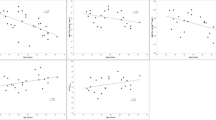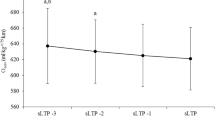Summary
Fifty-five male runners aged between 30 to 80 years were examined to determine the relative roles of various cardiovascular parameters which may account for the decrease in maximal oxygen uptake (\(\dot V_{o_{2max} } \)) with aging. All subjects had similar body fat composition and trained for a similar mileage each week. The parameters tested were\(\dot V_{o_{2max} } \), maximal heart rate (HR max), cardiac output (Q), and arteriovenous difference in oxygen concentration (C a —C ¯v) O2 during graded, maximal treadmill running. Average body fat and training mileage were roughly 12% and 50 km·week−1, respectively. The average 10-km runtime slowed significantly by 6.0%·decade−1 {[10-km run-time (min)=0.323 x age (years)+24.4] (n=49,r=0.692,p<0.001)}. A strong correlation was found between age and\(\dot V_{o_{2max} } \) {[\(\dot V_{o_{2max} } \) (ml·kg−1·min−1)=- 0.439xage+76.5] (n=55,r=-0.768, p<0.001)}. Thus,\(\dot V_{o_{2max} } \) decreased by 6.9%·decade−1 along with reductions ofHR max (3.2%·decade−1, p<0.001) andQ (5.8%·decade−1, p<0.001), while no significant change with age was observed in estimated (C a —C ¯v) O2. It was concluded that the decline of\(\dot V_{o_{2max} } \) with aging in runners was mainly explained by the central factors (represented by the decline ofHR andQ in this study), rather than by the peripheral factor (represented by (C a —C ¯v) O2).
Similar content being viewed by others
References
Allen TH, Andersen EC, Langham WH (1960) Total body potassium and gross body composition in relation to age. J Gerontol 15:348–357
Aniansson A, Gustafsson E (1981) Physical training in elderly man with special reference to quadriceps muscle strength and morphology. Clin Physiol 1:87–89
Aniansson A, Grimby G, Nygaard E, Saltin B (1980) Muscle fiber composition and fibre area in various age groups. Muscle Nerve 2:271–272
Aniansson A, Grimby G, Hedbery M, Korotkiewski M (1981) Muscle morphology, enzyme activity and muscle strength in elderly men and women. Clin Physiol 1:73–86
Asmussen E, Nielsen M (1956) Physiological dead space and alveolar gas pressure at rest and during muscular exercise. Acta Physiol Scand 38:1–21
Åstrand I (1960) Aerobic work capacity in men and women with special reference to age. Acta Physiol Scand 169:1–92
Åstrand P-O, Rodahl K (1986) Textbook of Work Physiology, 3rd edn. McGraw-Hill, New York
Brozěk J, Grand J, Anderson JT, Keys A (1963) Densitometric analysis of body composition: revision of some quantitative assumptions. Ann NY Acad Sci 110:113–140
Ekblom B, Hermansen L (1968) Cardiac output in athletes. J Appl Physiol 25:619–625
Defares JG (1958) Determination ofP vCO2 from the exponential CO2 rise during rebreathing. J Appl Physiol 13:159–164
Gerstenblith G, Lakatta EG, Weisfeldt ML (1976) Age changes in myocardial function and exercise response. Prog Cardiovasc Dis 19:1–21
Grimby G, Saltin B (1966) Physiological analysis of physically well trained middle-aged and old athletes. Acta Med Scand 176:513–526
Grimby G, Danneskiold-Samsøe B, Hvid K, Saltin B (1982) Morphology and enzymatic capacity in arm and leg muscles in 78–81 year old men and women. Acta Physiol Scand 115:125–134
Hagberg JM, Allen WK, Seals DR, Hurley BF, Ehsani AA, Holloszy JO (1985) A hemodynamic comparison of young and older endurance athletes during exercise. J Appl Physiol 58:2041–2046
Heigenhauser DJF, Faulkner JA (1978) Estimation of cardiac output by the CO2 rebreathing method during tethered swimming. J Appl Physiol 44:821–824
Jernerus R, Lundin G, Thomson D (1963) Cardiac output in healthy subjects determined with a CO2 rebreathing method. Acta Physiol Scand 59:390–399
Jones NL, Campbell EJM (1982) Clinical exercise testing, 2nd edn. Saunders, Philadelphia
Julius S, Amery A, Withlock LS, Conway J (1967) Influence of age on the hemodynamic response to exercise. Circulation 36:222–230
Klausen K (1965) Comparison of CO2 rebreathing and acetylene methods for cardiac output. J Appl Physiol 20:763–766
Lakkata EC (1986) Hemodynamic adaptations to stress with advancing aging. Acta Med Scand 711:39–52
Nagamine S, Suzuki S (1964) Anthropometry and body composition of Japanese young men and women. Hum Biol 36:8–15
Örlander J, Aniansson A (1980) Effects of physical training on skeletal muscle metabolism and ultrastructure in 70 to 75 year-old men. Acta Physiol Scand 109:149–154
Örlander J, Kiessling KH, Larsson L, Karlsson K, Aniansson A (1978) Skeletal muscle metabolism and ultrastructure in relation to age in sedentary men. Acta Physiol Scand 104:249–261
Pollock ML, Miller HS, Willmore J (1974) Physiological characteristics of champion American track athletes 40 to 75 years of age. J Gerontol 29:645–649
Robinson S (1938) Experimental studies of physical fitness in relation to age. Arbeitsphysiologie 10:251–323
Salmons S, Henriksson J (1981) The adaptive response of skeletal muscle to increased use. Muscle Nerve 4:94–105
Saltin B (1977) The interplay between peripheral and central factors in the adaptive response to exercise and training. Ann NY Acad Sci 301:224–231
Saltin B, Åstrand P-O (1967) Oxygen uptake in athletes. J Appl Physiol 23:353–358
Seals DR, Hagberg JM, Hurley BF, Ehsani AA, Holloszy JO (1984) Endurance training in older men and women. I. Cardiovascular responses to exercise. J Appl Physiol 57:1024–1029
Sidney KH, Shephard RJ (1978) Frequency and intensity of exercise training for elderly subjects. Med Sci Sports 10:125–131
Tzandoff SP, Norris AH (1977) Effect of muscle mass decrease on age-related BMR changes. J Appl Physiol 43:1001–1006
Author information
Authors and Affiliations
Additional information
This study was supported, in part, by a Research Grant on Aging and Health, Ministry of Health and Welfare, Japan, and by a Research Grant for young researchers, Meiji Life Foundation of Health and Welfare, Japan.
Rights and permissions
About this article
Cite this article
Fuchi, T., Iwaoka, K., Higuchi, M. et al. Cardiovascular changes associated with decreased aerobic capacity and aging in long-distance runners. Europ. J. Appl. Physiol. 58, 884–889 (1989). https://doi.org/10.1007/BF02332223
Accepted:
Issue Date:
DOI: https://doi.org/10.1007/BF02332223




